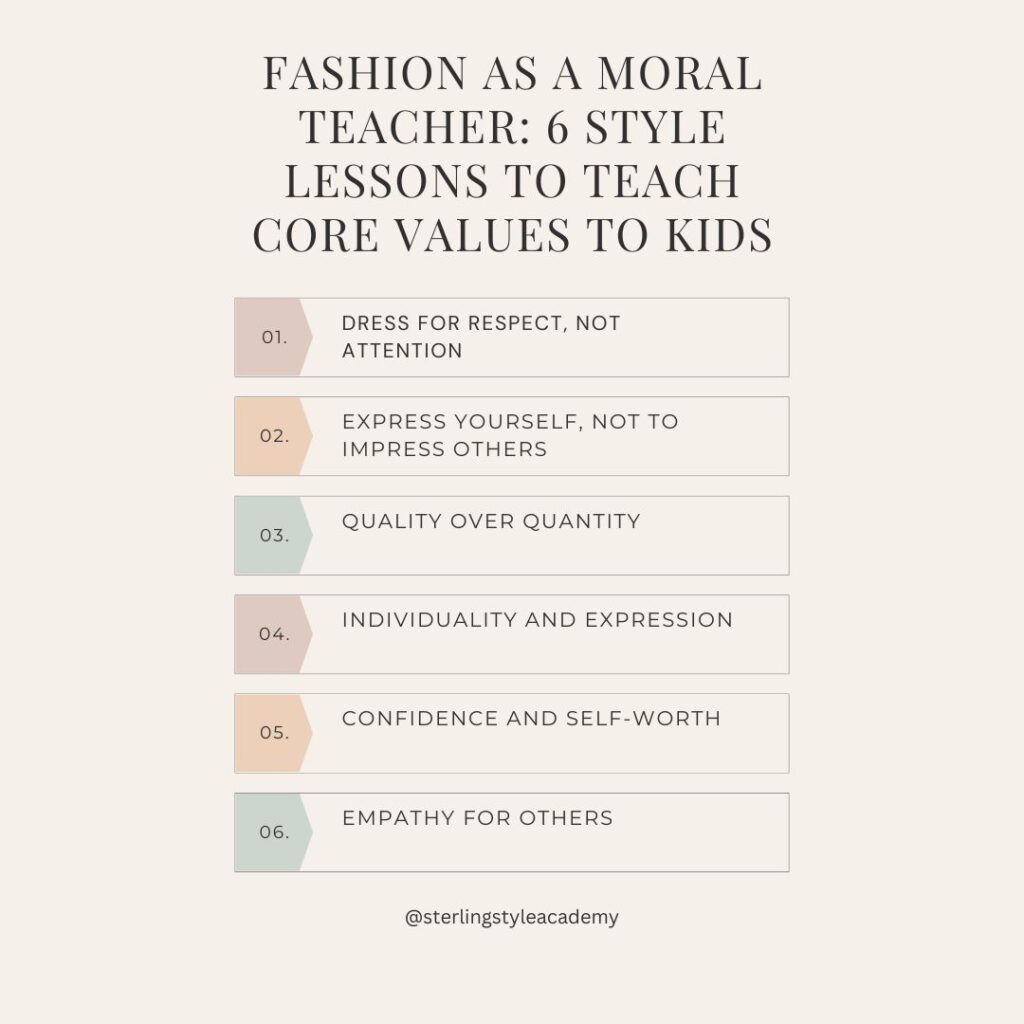Teaching core values to kids is not often easy however it is essential to the development of our society. Parenting is a perpetual exercise in instilling values. Our kids are the plungers of our legacy, and they absorb not just what we say, but who we are. Style can be a surprising catalyst for the profound lessons that we often endeavor to impart. In fashioning the next generation, we can leverage the everyday canvas of clothing to teach children essential values that will sculpt not just their wardrobes, but their characters.
- Core Values Introduction
- Teaching Core Values to Kids 1: Self-Expression and Confidence through Dressing
- Teaching Core Values to Kids 2: Respect and Understanding of Diversity in Fashion
- Teaching Core Values to Kids 3: Creativity and Problem-Solving Skills in Choosing Outfits
- Teaching Core Values to Kids 4: Responsibility and Care for Personal Presentation
- Teaching Core Values to Kids 5: The Importance of First Impressions and Respect for Occasions
- Teaching Core Values to Kids 6: Financial Literacy and Making Informed Fashion Choices
- Teaching Core Values to Kids 7: Environmental Awareness and Sustainable Fashion
- Conclusion
- 11 Good Moral Values for Kids You Can Teach Through Style
- Moral Values for Kids 1. Quality over Quantity
- Moral Values for Kids 2. Respect for Resources
- Moral Values for Kids 3. The Art of Storytelling
- Moral Values for Kids 4. Individuality and Expression
- Moral Values for Kids 5. Confidence and Self-Worth
- Moral Values for Kids 6. Humility and Modesty
- Moral Values for Kids 7. Empathy for Others
- Moral Values for Kids 8. Respect for Occasions
- Moral Values for Kids 9. Gratitude for What We Have
- Moral Values for Kids 10. The Practice of Grooming and Presentation
- Moral Values for Kids 11. The Fun in Experimentation
- Fashion as a Moral Teacher: 3 Style Lessons to Teach Core Values to Kids
- 3 Moral Values You Can Teach Your Kids Through Style: Raising Ethical Aesthetes
Core Values Introduction
Style matters; there’s no arguing that. And when we harness this truism in the upbringing of our children, we tap into an underutilized teaching platform. From the colors they choose to the events they dress for, our kids make style-based decisions daily. Understanding how these choices can speak to greater life principles can be a game-changer in parenting.
Teaching Core Values to Kids 1: Self-Expression and Confidence through Dressing
Our kids are constantly developing a sense of self, learning that it’s okay to be unique. Encouraging them to express their personalities through their dress fosters an environment of self-confidence. When they select their clothes based on what makes them feel good and what they like, they’re learning that their individuality is to be celebrated, not hidden.
A good way to instill this value is to involve them in the shopping process. Ask for their input on what they like and why. Show them how to mix and match to create outfits that reflect their individual style. The more input they have, the more they will feel that their opinion matters and their personality is seen and heard.
Teaching Core Values to Kids 2: Respect and Understanding of Diversity in Fashion
In our interconnected world, fashion is a powerful means of understanding and respecting diverse cultures and traditions. When we teach our children to appreciate and honor clothing from various backgrounds and ethnicities, we help them to develop open minds and hearts. This translates into a wider understanding and respect for diverse people and perspectives.
An effective way to convey this value is through exploration. Learn together about the significance of different cultural garments. Discuss how they carry history and meaning. When kids understand that the clothes they see represent more than just a fashion choice, they can begin to see the richer world beyond the fabric.
Teaching Core Values to Kids 3: Creativity and Problem-Solving Skills in Choosing Outfits
Style is often about making the most of what you have. When children are challenged to come up with a great outfit from their closet, they learn to think creatively and solve problems with the resources at hand. It’s not about having the most clothing, but about being resourceful and inventive.
An approach to nurturing this skill is by setting creative challenges. Encourage your child to create themed outfits, like a ‘superhero day’ or ‘beach party’, using what they already have. This not only fosters creativity but also teaches them to think ahead and plan, skills that will serve them well in many other areas of their lives.
Teaching Core Values to Kids 4: Responsibility and Care for Personal Presentation
Teaching kids to care for their clothes is more than just about cleanliness; it’s about respecting their belongings and understanding the value of presentation. When they’re responsible for washing, folding, and putting away their outfits, they learn the effort that goes into keeping up appearances and maintaining their possessions.
One method to ingrain this value is to establish a relationship of care with their clothes. Show them how to properly hang items, fold them to avoid creases, and remove stains. Teaching them to care for their clothes also instills the idea of wastefulness and how much effort goes into the things we enjoy.
Teaching Core Values to Kids 5: The Importance of First Impressions and Respect for Occasions
Illustrate this concept by discussing with them the various ways they can dress from casual to formal, and the reasons for doing so. Sharing family values and social etiquette as they pertain to clothing is an important aspect of this lesson.
Teaching Core Values to Kids 6: Financial Literacy and Making Informed Fashion Choices
In a world that can be materialistic, it’s important to teach children the value of money. Fashion is a prime area to show them how to make informed purchases, balancing quality with price and understanding the cost of their choices.
When out shopping, consider discussing the cost of clothing and how to weigh whether an item is worth its price. Teach them to look for quality and how taking care of clothes can make them last longer. These lessons will not only teach them financial literacy but also the principles of value and investment in what they own.
Teaching Core Values to Kids 7: Environmental Awareness and Sustainable Fashion
The fashion industry is a significant contributor to environmental degradation, and it’s crucial that we teach our children about the impact of their clothes. By opting for sustainable fashion and teaching our children to do the same, we embed in them the value of being environmentally conscious.
One way to make this lesson tangible is by engaging in upcycling projects. Show your child how to transform old clothing into something new and fashionable. This not only cuts down on waste but also teaches them the benefit of thinking creatively and sustainably.
Conclusion
By recognizing the teachable moments in our children’s style choices, we open up a world of opportunity for them to learn values that they can carry through life. From understanding diversity to being financially savvy, fashion is more than just what we wear—it’s a reflection of our core principles. It’s through this medium that we can shape not just our kids’ outward presentation, but the very essence of their beings.

11 Good Moral Values for Kids You Can Teach Through Style
In the midst of glossy magazine spreads and the ceaseless churn of fast fashion trends, the art of dressing with integrity and personal values is often lost. But what if we could use style as a canvas to instill deeper moral values in our children from a young age? This post isn’t about dictating a dress code for your little ones—it’s about using fashion to communicate and embody important life lessons. Your child’s clothes can be a powerful tool to teach them about responsibility, respect, and empathy.












Moral Values for Kids 1. Quality over Quantity
Encourage your child to appreciate well-made clothes over the abundance of cheap, disposable items. Teach them to value the craftsmanship and effort that goes into each piece. This lesson extends beyond fashion; it’s about developing an eye for quality in all aspects of life, from friendships to work projects. When they understand the value of quality, they will come to expect it in their own endeavors.
Moral Values for Kids 2. Respect for Resources
By explaining how clothing is made, you can show your children the resources and energy that go into the process. Talk about water consumption, chemical usage, and the overall environmental impact. Lead by example and choose sustainable clothing brands to show respect for the planet and its resources.
Moral Values for Kids 3. The Art of Storytelling
Every outfit tells a story, whether your child is aware of it or not. Help them discover the narrative their clothes are communicating, especially when attending events or important occasions. Their attire should reflect the message they wish to convey and the image they hope to project.
Moral Values for Kids 4. Individuality and Expression
Fashion should celebrate the unique character of your child. Help them choose clothes that reflect their personal style and interests, rather than succumbing to peer pressure. This translates into a celebration of individuality that is important for self-esteem and decision-making.
Moral Values for Kids 5. Confidence and Self-Worth
The right outfit can influence one’s confidence and self-worth. Teach your child that their appearance does not define their value as a person. Instead, it’s about how they carry themselves and the inner self they project outwardly. Self-worth should come from their accomplishments and character.
Moral Values for Kids 6. Humility and Modesty
While it’s important to build self-confidence, it’s equally crucial to teach children that humility and modesty are admirable traits. This can be reflected in their dressing style, choosing clothes that don’t seek undue attention or provoke envy.
Moral Values for Kids 7. Empathy for Others
Encourage your child to understand the impact of their appearance on others. Clothes should not only be comfortable and an expression of self but also considerate of cultural norms and environments. This is an important foundation for empathy and understanding others’ perspectives.
Moral Values for Kids 8. Respect for Occasions
Instill in your child the importance of dressing appropriately for different occasions. This is a way to show respect for the event and the people involved. Discuss with them why we dress differently for a wedding than we do for a casual playdate.
Moral Values for Kids 9. Gratitude for What We Have
Being mindful of the privilege of having clothes to wear can help cultivate gratitude in your child. Discuss the importance of looking after their clothes and how not everyone is as fortunate. This is an opportunity to talk about charity and the concept of giving to those in need.
Moral Values for Kids 10. The Practice of Grooming and Presentation
Maintaining personal hygiene and being presentable is a form of respect for oneself and others. This extends to the condition of your clothes. Teach your children to care for their belongings and the importance of presenting themselves well in various situations.
Moral Values for Kids 11. The Fun in Experimentation
Style is a fun way to experiment and explore different looks. Encourage your child to try new things and have fun with fashion. This will teach them about the joy in creativity and the power of feeling good in their own skin.
By integrating these values into everyday conversations about fashion, we can guide our children towards a more mindful and respectful approach to style—not just for them but for the world they will inherit. After all, good moral values are always in fashion.

Fashion as a Moral Teacher: 3 Style Lessons to Teach Core Values to Kids
When it comes to raising our children, we understand the importance of teaching them good morals and values from a young age. Yet, in the flurry of everyday parenting, it’s easy to underestimate the power of the little things in life, like the clothes we put on our kids in the morning.
This blog post explores fashion as more than just fabric and styles. It’s a reflection of how we interact with the world, our self-perception, and our values. In other words, it’s a great platform to teach your kids about life’s bigger picture. Here are three style lessons that can go beyond the fashion angle and help shape your children’s characters from a very early age.
Style Lesson 1 Core Values to Kids: Dress for Respect, Not Attention
The first lesson we can impart through style is the notion of dressing for respect, not attention. In our modern world, morality is often measured by our actions and less so by appearance. But that doesn’t diminish the importance of how we present ourselves, especially to a child’s developing mind.
Why Modesty Matters
Modesty can be a tricky topic in the fashion world. We’re surrounded by images of celebrities and influencers flaunting their figures, leading many to believe that to be noticed, one must bare all. However, teaching your child to dress modestly is not about hiding their bodies; it’s about valuing their worth beyond appearance.
Dressing for Success
Studies have shown that dressing well can lead to better performance and higher expectations in the workplace. While this may be a lesson for when they’re older, dressing for respect now can ingrain the habit of taking pride in one’s appearance without seeking constant approval.
The Lesson Plan
Begin by emphasizing that their self-worth comes from within. Clothes are not armor to protect against outside opinion but a way to reflect the respect they have for themselves. Show them how a combination of well-chosen clothes and good personal hygiene can lead to a sense of empowerment that radiates self-respect.
Style Lesson 2 Core Values to Kids: Express Yourself, Not to Impress Others
Style is a language of its own; it can speak volumes about who we are and how we wish to be perceived. However, style should be a tool for self-expression, not a means to an end or to impress others.
Peer Pressure in the Closet
Children, especially as they grow into teenagers, face immense pressure to conform to peer expectations. They’re at an age where individuality is both sought after and feared. By encouraging your children to dress in ways that make them feel happy and confident, you can lay a foundation for them to value their uniqueness.
Avoiding the Brand Trap
We live in a society that often ties brand names with worth. Reframing the conversation around clothes can teach kids to appreciate items for their design and how they make them feel, rather than for the logos they bear.
Crafting an Individual Look
Help your kids understand that there’s a difference between following a trend and expressing personal style through conscious choices. Create a safe space for them to explore fashion by involving them in decisions about their wardrobe.
Style Lesson 3 Core Values to Kids: Quality Over Quantity
Finally, the quality of clothing and the lesson of sustainable consumption are crucial moral compasses to instill.
The True Cost of Cheap Fashion
The rise of fast fashion has made clothing more accessible and disposable. But the true cost lies in the unethical production and environmental damage. By opting for fewer, high-quality pieces, we teach our children to consider the impact of their possessions.
The Joy of Longevity
There’s satisfaction in cherishing a garment for years, in seeing it as an old friend rather than something to be discarded after a season. Teach them to maintain their clothes, seeing through repairs and alterations to give a second life to their beloved items.
Actions Over Words
Responsible fashion choices build character. Engage your children in making conscious decisions about their clothing. Visit thrift stores, discuss why certain materials are preferred, and make environmentally friendly choices together.
Conclusion: The Long-Term Impact of Style as a Teacher
These three lessons, woven through the cloth of fashion, are much more than tactical dressing advice. They are foundational to raising compassionate, respectful, and self-assured individuals. By engaging your children in discussions about modesty, individuality, and sustainability through the lens of style, you set them on a path of thoughtful living.
Remember, as parents and guardians, your own actions and choices, be it in fashion or other aspects of life, serve as the most potent lessons. By living out these values and openly discussing the reasoning behind them, your children will grow up to be not just well-dressed, but well-rounded, moral individuals. Teach them through style, and you teach them for life.





3 Moral Values You Can Teach Your Kids Through Style: Raising Ethical Aesthetes
As a parent or guardian, the responsibility of imparting moral values onto your children ranks amongst your most crucial duties. But how can you make ethics lessons both compelling and practical? The answer might just lie in an unlikely arena: style. Fashion isn’t just about the clothes we wear; it’s a powerful vehicle for self-expression and a mirror that reflects our values. By teaching your kids to compose their appearance thoughtfully, you can impart profound lessons about the person they’re becoming. Here are three moral tips you can instill in your children through their sartorial choices.
Moral Values for Kids 1: “Speak the Truth” with Colors and Fabrics
When your child is picking an outfit, discuss the meanings and associations of the colors and fabrics they choose. The Myth of the Blue Lie Parents often advise kids to avoid lying, but they may not grasp why. Using blue as an example, explain that it’s commonly associated with loyalty and honesty, so dressing in blue could serve as a visual reminder to speak the truth. The connection between color and truthfulness is a powerful tool for children to understand honesty on a visceral level.
Understated Elegance vs. Flashy Affirmations
To contrast, loud or ill-matched outfits might signify overcompensation or a desire to be seen in a certain way. Addressing this signals to your child the type of impression they could unintentionally project and highlights the difference between stating their truth and demanding attention. It’s an entry point for conversations on humility and self-assuredness.
Moral Values for Kids 2: “Ask for What You Want, Don’t Manipulate” Through Wardrobe Choices
Styles that mirror your child’s true desires without resorting to social manipulation can teach a critical life lesson. Express the Subtlety of Needs Allow your child the freedom to pick clothes that match their mood or interests that day but encourage them to express their desires directly without attempting to subtly coerce others into meeting their needs through clothing choices. It’s a small but potent lesson in being authentic and direct in their interactions.
The Moral of Modesty
Similarly, modest choices can be explained as a recognition of others’ feelings and an understanding that our attire, as a form of communication, should be respectful. This can start conversations about consent and setting boundaries, crucial topics as your child navigates peer and romantic relationships.
Moral Values for Kids 3: “Believe in Yourself” by Defying Trends
Encourage your children to wear what makes them feel good, not just what’s popular. Explain that Self-Expression Defies Conformity Trends are often born out of a collective yearning for identity. By eschewing trends, your child can learn to find their voice as an individual, not just another follower.
The Power of Personal Style
This philosophy extends the meaning of fashion from mere clothing to a characteristic of a person. Discuss different style icons or fashion revolutionaries who stayed true to their vision, imparting the idea that authentic self-expression can be influential and powerful. This is a step towards fostering a strong, independent mindset and instilling the value of self-belief.
Through these discussions, you’ll notice a transformation in how your child approaches not just fashion, but life itself. They’ll begin to understand that every expression, including what they wear, is a canvas for their character. And in a world where the lines between right and wrong are often blurred, these seemingly trivial lessons in style could be the lanterns that guide them through life’s murkiest waters with clarity and integrity.
At first glance, teaching morals through style might seem superficial. But every layer of fabric that comprises an outfit holds a lesson waiting to be uncovered. Fashion can be the cloak that warms your child’s moral compass, and the compass that steers their choices towards goodness. Start these conversations early, and watch your little ones grow not just into fashion-forward individuals, but into moral exemplars in their communities.
The clothes on our backs are more than coverings; they are reflections of the soul. By guiding our children in the realm of style, we are sowing seeds that will blossom into an ethical worldview. Next time your child clamors to put on their favorite shirt, remember that it’s not just a shirt—it’s a chance to shape a conscience. The lessons might be subtle, but the impact is profound.
Conclusion
Teaching kids about morality can often feel like a complex, abstract task. But by using style as a lens through which to view ethical behavior, you can make these lessons accessible, tangible, and even fun. Discussing the ethical implications of various fashion choices opens the dialogue to talk about truthfulness, the value of authenticity, and the importance of self-belief in a way that is relevant and concrete for your child. Take this chance to turn fashion into a bonding experience and an opportunity to impart values that will stick with your kids for life.
Michelle T. Sterling is an American award-winning, internationally renowned image consultant, personal stylist, and online personal shopper. She’s available for in-person consultations if you’re located in New York, DC, San Francisco, Miami, or Dubai, or she provides virtual consultations to clients worldwide. Her style advice has been featured in the Wall Street Journal, CNN, Gulf News, Details Magazine, and Forbes, among others.

Your Online Personal Shopper + Stylist





Leave a Reply
You must be logged in to post a comment.